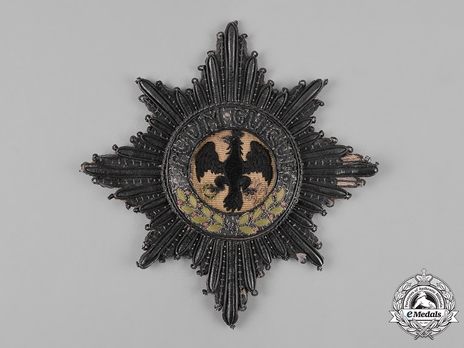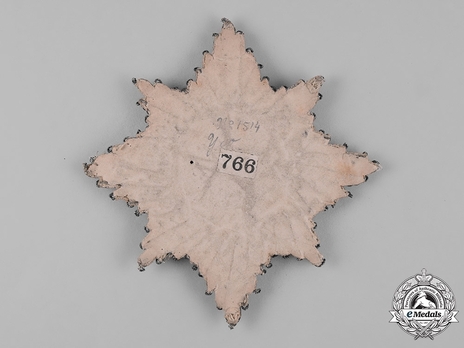High Order of the Black Eagle, Breast Star (embroidered mantle star)
CATEGORY: Version
SKU: 01.PRU.0101.103.01.001
Estimated market value:


Estimated market value:
An eight-pointed embroidered silver star, centre obverse depicts a black embroidered eagle with crown, beak, eye, and claws completed in golden bullion wire, clutching a wreath in green wool and thunderbolts in orange wire, bordered by a ring of golden embroidery bearing the motto SUUM CUIQUE in golden thread embroidery, the lower half with laurel branches in green silk with fruits in orange-red wool, this ring is bordered inside and out with twisted silver aluminum wire, the reverse presents a paper backing with a museum label showing the number 766 in addition to hand-writing in pencil, measuring 102 mm (w) x 106 mm (h), weighing 20.0 grams, some loss of colour and fading present, otherwise in very fine condition.
The High Order of the Black Eagle was founded by Elector Friedrich III of Brandenburg on the day before his coronation to become King Friedrich I of Prussia. Elector Friedrich III instituted the Order to demonstrate the importance and dignity of Prussia within the European hierarchy.
The order was primarily conferred upon foreign and domestic princes, heads of state, and dignitaries in recognition of extraordinary civil and military merit and achievements. It was also awarded to members of the Prussian military.
The black eagle was chosen to symbolize justice, and to represent the coat of arms of the state. The eagle clutches a laurel wreath in one claw, as the reward of justice, and a lightning bolt, the punishment of justice, in the other claw.
The statutes for the order were largely based on the Danish Order of the Elephant, British Order of the Garter, and Spanish Order of the Golden Fleece. In line with these other European orders, the number of Knights was set at 30, not including the royal princes who were awarded the order at the time of their birth. For non-royal Knights, the minimum age was set at 30. However, the membership limit was not observed between 1713 to 1847, when the 30 member limit only applied to residents.
From 1703 to 1847, the order was only awarded to members of nobility who could trace their lineage through multiple generations.
The order featured only one grade, which included a Collar, Cross, and an associated Breast Star. The reigning king could award the order with or without the collar. The order members had to wear their decorations at all times or risk fines for violating the order’s rules. Knights of foreign states were allowed to wear the cross on a neck ribbon or a ribbon bow on the chest.
The first 19 awards of the order took place on January 17, 1701. The recipients swore by the statutes and received the decoration on the shoulder ribbon at the appointment, and at the investiture would receive the chain from the king. In May 1742, Marie August, widowed Duchess of Württemberg, was the first woman to be awarded the order.
In 1809, King Friedrich Wilhelm III considered expanding the order into four classes, with a decoration with a wreath for sub-officials, etc. However, this plan was transferred to the Red Eagle Order in January 1810.
On February 20, 1847, King Friedrich Wilhelm IV amended the order to include individuals who were not of noble lineage. These recipients, in turn, would receive hereditary nobility.
The order decorations could be conferred with diamonds to members of royal families and other high-ranking recipients for exceptional merit. In 1743, Elisabeth Petronova, Empress of Russia was awarded the order with diamonds, with a value of 40,000 thalers. In 1762, Catherine II, Empress of Russia received the order with pearls, with a value of 30,000 thalers.
The order's motto was "Suum Cuique", which translates to “To each according to their merits”.
The order was discontinued in 1918.
The early Breast Stars of the order were embroidered. Manufacturers of the embroidered breast stars include: Matthias Emanuel Heinitschek between 1744 and 1761; Johannes Andreas Barth between 1755 and 1760; Johann Friedrich the Elder Kolbe between 1734 and 1750; Christian Wilhelm Kolbe between 1749 and 1786; Johann Friedrich Kolbe (undated); Christian Friedrich Kolbe between 1779 and 1792; H. Fehrmann, approx. between 1810 and 1830 (identified by the helically twisted silver wire on the medallion’s border). From 1858 onwards, metal stars were created.
Breast Stars with diamonds were awarded a total of 92 times, 71 of which between 1742 and 1900, 20 between 1908 and 1914, and one in 1932. The first award took place in November of 1742, to Imperial Russian Lieutenant General Mikahil Larionovich Count Vorontsov.
Another version is presented here in which the order of the Black Eagle and the Order of the Garter are combined. One historian, Heyde, claims that King Friederich I created an alliance order between the orders to demonstrate that he had been awarded both. The star has the garter wrapped around four points of the star. Another historian, Schneider, writes that the form would have been revived when King Friedrich Whilhem IV was awarded the Order of the Garter in England in 1843.
The Star has many versions, ranging in size and design. The Breast Star features both smooth rays, and filed or pebbled (faceted) rays, and ranges in size from 72 to 100mm.

Comments
Sign in to comment and reply.


Scroll Top